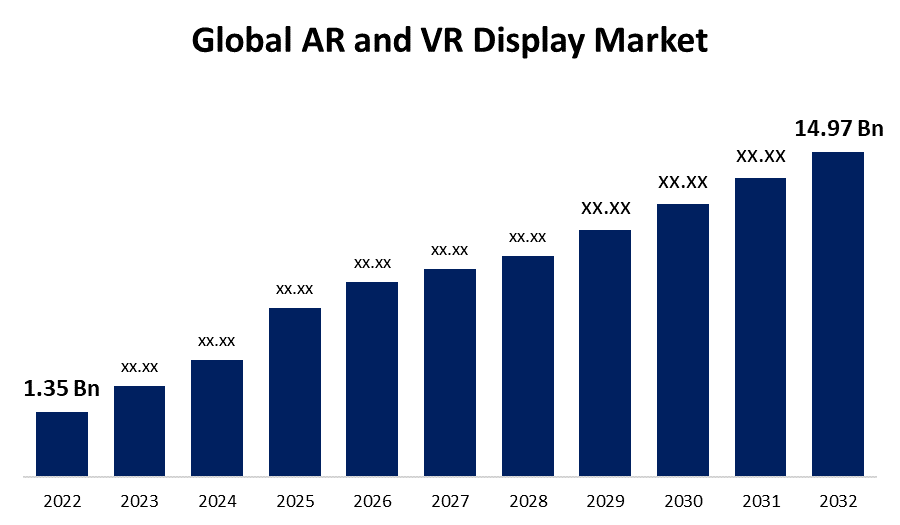Global AR and VR Display Market Size, Share, and COVID-19 Impact Analysis, By Technology (AR and VR), By Display Technology (OLED, LCD, and Others), By Device Type (AR HMDs, VR HMDs, AR HUDs, and VR Projectors), By Application (Consumer, Commercial, Manufacturing, Automotive, Healthcare, Aerospace & Defense, Energy, and Others), By Region (North America, Europe, Asia-Pacific, Latin America, Middle East, and Africa), Analysis and Forecast 2022 – 2032.
Industry: Semiconductors & ElectronicsGlobal AR and VR Display Market Insights Forecasts to 2032
- The Global AR and VR Display Market Size were valued at USD 1.35 Billion in 2022.
- The Market is Growing at a CAGR of 27.2% from 2022 to 2032
- The Worldwide AR and VR Display Market Size is expected to reach USD 14.97 Billion by 2032
- Asia-Pacific is Expected to highest growth during the forecast period

Get more details on this report -
The Global AR and VR Display Market Size is expected to reach USD 14.97 Billion by 2032, at a CAGR of 27.2% during the forecast period 2022 to 2032.
Market Overview
Augmented Reality (AR) and Virtual Reality (VR) displays are immersive technologies that revolutionize the way we perceive and interact with digital content. AR displays overlay computer-generated graphics onto the real world, enhancing our perception and providing additional information in real-time. They are typically achieved through headsets or smart devices, enabling users to experience a blended reality. On the other hand, VR displays create fully immersive virtual environments, blocking out the real world and transporting users to a computer-generated realm. VR headsets offer a 360-degree field of view, allowing users to explore and interact with real times and objects. Both AR and VR displays rely on high-resolution screens, precise tracking systems, and advanced optics to deliver immersive experiences. These technologies find applications in various fields, including gaming, education, healthcare, architecture, and more, unlocking new possibilities for entertainment, learning, and communication.
Report Coverage
This research report categorizes the market for AR and VR display market based on various segments and regions and forecasts revenue growth and analyzes trends in each submarket. The report analyses the key growth drivers, opportunities, and challenges influencing the AR and VR display market. Recent market developments and competitive strategies such as expansion, product launch, and development, partnership, merger, and acquisition have been included to draw the competitive landscape in the market. The report strategically identifies and profiles the key market players and analyses their core competencies in each sub-segment of the AR and VR display market.
Global AR and VR Display Market Report Coverage
| Report Coverage | Details |
|---|---|
| Base Year: | 2022 |
| Market Size in 2022: | USD 1.35 Billion |
| Forecast Period: | 2022-2032 |
| Forecast Period CAGR 2022-2032 : | 27.2% |
| 2032 Value Projection: | USD 14.97 Billion |
| Historical Data for: | 2018-2021 |
| No. of Pages: | 200 |
| Tables, Charts & Figures: | 120 |
| Segments covered: | By Technology, By Display Technology, By Device Type, By Application, By Region. |
| Companies covered:: | Samsung Electronics, Sony, LG Display, eMagin Corporation, Kopin Corporation, AU Optronics, Japan Display, Barco, BOE Technology, Syndiant. |
| Pitfalls & Challenges: | COVID-19 Empact, Challenge, Future, Growth, & Analysis |
Get more details on this report -
Driving Factors
The augmented reality (AR) and virtual reality (VR) display market is driven by several key factors due to the increasing demand for immersive and interactive user experiences across industries such as gaming, entertainment, healthcare, and education is fueling the growth of AR and VR displays. The advancements in display technologies, such as high-resolution screens and optics, contribute to the improved visual quality and realism of AR and VR experiences, further driving market growth. Additionally, the growing availability and affordability of AR and VR devices, including headsets and smart glasses, are making these technologies more accessible to consumers. Moreover, the development of supportive infrastructure, such as 5G networks, is facilitating seamless connectivity and enhancing the performance of AR and VR displays. Overall, the rising investments and collaborations in the AR and VR ecosystem by major technology companies and startups are spurring innovation and expanding the market opportunities for AR and VR displays.
Restraining Factors
The augmented reality (AR) and virtual reality (VR) display market also faces several restraints such as the high cost of AR and VR devices and associated hardware limits their widespread adoption, especially among price-sensitive consumers and businesses. The concerns regarding privacy and security in AR and VR experiences pose challenges to market growth. The potential health effects, such as motion sickness and eye strain, associated with prolonged AR and VR usage present barriers to mass adoption. Additionally, the limited availability of compelling and high-quality AR and VR content restricts the market expansion. Overall, regulatory and legal challenges, including intellectual property rights and data protection, can hinder the development and deployment of AR and VR technologies.
Market Segmentation
- In 2022, the OLED segment accounted for around 57.8% market share
On the basis of display technology, the global AR and VR display market is segmented into OLED, LCD, and others. The organic light emitting diode (OLED) segment has emerged as the leader in the AR and VR display market, holding the largest market share. This is primarily due to several advantages offered by OLED technology. OLED displays provide vibrant colors, high contrast ratios, and deep blacks, delivering an exceptional visual experience in both AR and VR applications. Additionally, OLED panels offer faster response times, reducing motion blur and improving the overall viewing experience, especially in fast-paced virtual environments. The flexibility and thinness of OLED panels enable the creation of lightweight and compact AR and VR devices. Furthermore, OLED's ability to deliver true blacks enhances the immersion and realism of virtual environments. These advantages have led to significant adoption of OLED displays in AR and VR headsets, contributing to its dominance and largest market share in the industry.
- In 2022, the HMDs devices hold the major market share with more than 37.4%
Based on the device type, the global AR and VR display market is segmented into AR HMDs, VR HMDs, AR HUDs, and VR projectors. Head-mounted displays (HMDs) have emerged as the frontrunner in the augmented reality (AR) and virtual reality (VR) display market, holding the major market share. The popularity of HMDs can be attributed to several factors because HMDs offer a highly immersive experience, blocking out the real world and transporting users to virtual environments. This has made them a preferred choice for gaming, entertainment, and simulation applications. HMDs come in various forms, including tethered, standalone, and mobile, providing flexibility and catering to different use cases and user preferences. The advancements in HMD technology have led to improved resolution, field of view, and tracking accuracy, enhancing the overall visual quality and user experience. Additionally, the availability of a wide range of content and applications compatible with HMDs has further bolstered their market dominance. With continuous innovations and expanding applications, HMDs are expected to maintain their major market share in the AR and VR display industry.
Regional Segment Analysis of the AR and VR Display Market
- North America (U.S., Canada, Mexico)
- Europe (Germany, France, U.K., Italy, Spain, Rest of Europe)
- Asia-Pacific (China, Japan, India, Rest of APAC)
- South America (Brazil and the Rest of South America)
- The Middle East and Africa (UAE, South Africa, Rest of MEA)
Asia-Pacific dominated the market with more than 45.6% revenue share in 2022.

Get more details on this report -
Based on region, the Asia-Pacific region has emerged as a dominant player in the augmented reality (AR) and virtual reality (VR) market, holding the largest market share. Several factors contribute to this trend because the region is home for some of the world's largest consumer markets, including China, Japan, and South Korea, which have a high adoption rate of advanced technologies. Additionally, the rapid economic growth and increasing disposable incomes in these countries have fueled the demand for immersive and interactive experiences. Furthermore, Asia-Pacific boasts a robust ecosystem of technology companies, startups, and developers that are driving innovation in AR and VR. Government initiatives and investments in emerging technologies also contribute to the market's growth. Moreover, various industries, including gaming, entertainment, manufacturing, healthcare, and education, in the Asia-Pacific region have recognized the potential of AR and VR, leading to their widespread adoption and driving the region's market share.
Recent Developments
- In February 2022, Sony has unveiled a partnership with Niantic to enhance and broaden its range of AR hardware. The primary focus of this collaboration will revolve around the advancement of AR technology specifically for headphones.
Competitive Analysis
The report offers the appropriate analysis of the key organizations/companies involved within the global AR and VR display market along with a comparative evaluation primarily based on their product offering, business overviews, geographic presence, enterprise strategies, segment market share, and SWOT analysis. The report also provides an elaborative analysis focusing on the current news and developments of the companies, which includes product development, innovations, joint ventures, partnerships, mergers & acquisitions, strategic alliances, and others. This allows for the evaluation of the overall competition within the market.
List of Companies:
- Samsung Electronics
- Sony
- LG Display
- eMagin Corporation
- Kopin Corporation
- AU Optronics
- Japan Display
- Barco
- BOE Technology
- Syndiant
Key Target Audience
- Market Players
- Investors
- End-Users
- Government Authorities
- Consulting and Research Firm
- Venture Capitalists
- Value-Added Resellers (VARs)
Market Segment
This study forecasts revenue at global, regional, and country levels from 2022 to 2032. Spherical Insights has segmented the global AR and VR display market based on the below-mentioned segments:
AR and VR Display Market, By Technology
- AR
- VR
AR and VR Display Market, By Display Technology
- OLED
- LCD
- Others
AR and VR Display Market, By Device Type
- AR HMDs
- VR HMDs
- AR HUDs
- VR Projectors
AR and VR Display Market, By Application
- Consumer
- Commercial
- Manufacturing
- Automotive
- Healthcare
- Aerospace & Defense
- Energy
- Others
AR and VR Display Market, Regional Analysis
- North America
- US
- Canada
- Mexico
- Europe
- Germany
- UK
- France
- Italy
- Spain
- Russia
- Rest of Europe
- Asia Pacific
- China
- Japan
- India
- South Korea
- Australia
- Rest of Asia Pacific
- South America
- Brazil
- Argentina
- Rest of South America
- Middle East & Africa
- UAE
- Saudi Arabia
- Qatar
- South Africa
- Rest of Middle East & Africa
Need help to buy this report?